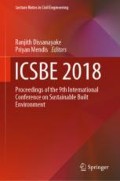Abstract
When properly managed, grey water can be a valuable resource, which agricultural and horticultural practitioners as well as home gardeners can benefit from using to provide an excellent nutrient sources for vegetation. Natural treatment systems such as constructed wetlands emphasizing on sustainability and wastewater reuse typically for agricultural irrigation/home gardening can be considered as an ideal alternative to close the loop in terms of nutrient capture and water conservation. This paper presents a part of an analysis done to estimate the locally derived treatment wetland parameters based on BOD5 removal mechanisms of a pilot scale subsurface horizontal flow constructed wetland (SSHF CW) treating greywater. A pilot scale SSHF CW with a surface area of 8.64 m2 and a substrate depth (with 20 mm aggregates) of 0.7 m was monitored. This is a part of a long term study carried out to test the viability of SSHFCW for treating grey water for agricultural reuse. The wastewater flow measurements were taken from the inlet and the outlet of the constructed wetland while monitoring the hydraulic (HRT) and organic loading rates. Water samples from four sampling points were collected on a long term basis. Equations based on a kinetic model of a first-order piston flow reactor was used to calculate the relationship among the design parameters appropriate for local conditions. The HRT varied from 3.3 to 4.7 d for maximum and minimum inflow loading rates observed. Using the data from the current study, a resizing exercise for a subsurface horizontal flow constructed wetland was carried out. Accordingly, a household with four people, discharging 720 L/d greywater with an average influent BOD5 of 300 mg/L could be treated up a BOD5 concentration of 25 mg/L using an area of 3.60 m2 of SSHF CW, implying only 0.975 m2 of per capita land usage.
Access this chapter
Tax calculation will be finalised at checkout
Purchases are for personal use only
References
Andreo-Martínez P, García-Martínez N, Almela L (2016) Domestic wastewater depuration using a horizontal subsurface flow constructed wetland and theoretical surface optimization: a case study under dry Mediterranean climate. Water 8:434. https://doi.org/10.3390/w8100434
Chazarenc F, Merlin G, Gonthier Y (2003) Hydrodynamics of horizontal subsurface flow constructed wetlands. Ecol Eng 21:165–173
Economopoulo MA, Tsihrintzis VA (2003) Design methodology and area sensitivity analysis of horizontal subsurface flow constructed wetlands. Water Resour Manage 17:147–162
García J, Chiva J, Aguirre P, Alvarez E, Sierra JP, Mujeriego R (2004) Hydraulic behaviour of horizontal subsurface flow constructed wetlands with different aspect ratio and granular medium size. Ecol Eng 23:177
Langergraber G (2008) Modeling of processes in subsurface flow constructed wetlands—a review. Vadoze Zone J 7(2):830–842
Karunaratne S, Wijesiri BS, Jayasooriya VM (2011) Estimation of reaction rate constants of pollution removal for subsurface flow constructed wetlands treating grey water. In: Proceedings of IESL-SSMS joint international symposium, SSMS 2011, 14th – 16th September 2011, Colombo, Sri Lanka, pp 289–293
Małoszewski P, Wachniew P, Czupryński P (2006) Study of hydraulic parameters in heterogeneous gravel beds: constructed wetland in Nowa Słupia (Poland). J Hydrol 331:630–642
Reed SC, Crites RW, Middlebrooks EJ (1995) Natural systems for waste management and treatment, 2nd edn. McGraw-Hill, New York, p 433
Sri Lanka standard code of practise for the design and construction of septic tanks and associated effluent disposal systems SLS 745-Part 2
Udukumburage RS, Ariyasena MADN, Rupasinghe GGMBMB, Karunarathne S (2013) Effect of hydraulic loading rate on treatment efficiency of a subsurface horizontal flow constructed wetland. In: Proceedings of Sri Lanka water convention 2013, 20–21 March 2013, Colombo, Sri Lanka
Vymazal J (2005) Horizontal sub-surface flow and hybrid constructed wetlands systems for wastewater treatment. Ecol Eng 25(5):478–490. https://doi.org/10.1016/j.ecoleng.2005.07.010
Vymazal J (2011) Constructed wetlands for wastewater treatment. Environ Sci Technol 45:61–69
Werner TM, Kadlec RH (2000) Wetland residence time modeling. Ecol Eng 15:77–90
Wynn TM, Liehr SK (2001a) Development of a constructed subsurface flow wetland simulation model. Ecol Eng 16:519–536
Wynn TM, Liehr SK (2001b) Development of a constructed sub-surface flow wetland simulation model. Elsevier Science, Amsterdam, pp 1–18
Acknowledgements
The author would like to acknowledge the contributions by Udukumburage RS, Ariyasena MADN, Rupasinghe GGMBMB, Wijesiri, B. S., Jayasooriya, V. M. for the field work as well as laboratory analysis done in relation to this work.
Author information
Authors and Affiliations
Corresponding author
Editor information
Editors and Affiliations
Rights and permissions
Copyright information
© 2020 Springer Nature Singapore Pte Ltd.
About this paper
Cite this paper
Karunaratne, S. (2020). Effective Sizing of Natural Systems for Grey Water Treatment Using Locally Derived Parameters. In: Dissanayake, R., Mendis, P. (eds) ICSBE 2018. ICSBE 2018. Lecture Notes in Civil Engineering , vol 44. Springer, Singapore. https://doi.org/10.1007/978-981-13-9749-3_18
Download citation
DOI: https://doi.org/10.1007/978-981-13-9749-3_18
Published:
Publisher Name: Springer, Singapore
Print ISBN: 978-981-13-9748-6
Online ISBN: 978-981-13-9749-3
eBook Packages: EngineeringEngineering (R0)

